
Scholar
yarn, steel, slate, kranite, felt and other diverse things; 60 x 68 x 6 in.
I planned out this rug last fall, I was thinking about historical scholars and knowledge seekers in western histories that were accused of heresy; I was thinking about how many demons I have come across in western esoterica that were called upon to gain knowledge in the sciences—biology, astrology, alchemy and anatomy; I was thinking about mythological spirits of knowledge, Hecate and Morgana, who were maliciously maligned, pushed aside for the rise of Christianity.
I started knotting this rug as government websites were scrubbed and changed to remove references to inclusion, diversity, gender and as well as minorities and transgendered people, among other terms, in January; I knotted this rug as I watched the news of Columbia Univ. Grad student Mahmoud Khalil got ripped away from his pregnant US Citizen wife in March; I knotted this rug in April following the news about the current US administration attacking universities; I knotted this rug in May as I watched President Trump sign an executive order seeking to stop direct federal funding to NPR and PBS.
On Rugs:
If you think of my work as a family tree, my rugs are the parents to the carpet beaters, the bells, the needle and possibly future work. The rugs represent a more of an archetypal or totemic figure—the Whore, the Crone, the Warrior, the Mother and the Heretic, to name a few.
I see rugs as objects of spatial transitions and a protective barrier—their soft borders protecting whether they are on the wall, floor or resting on one's shoulders. Keeping in mind notions of the occult, the rugs take on the motif of the magic circle which, in itself, is a boundary but it is also more than that—it is a passage, a gateway, a portal between the natural and supernatural. The rug is not necessarily used to hide something from us but to reveal the hiddenness in the world, our world—the world-in-itself vs. the world-for-us.

Scholar
Detail

Scholar
Detail

Scholar
Detail
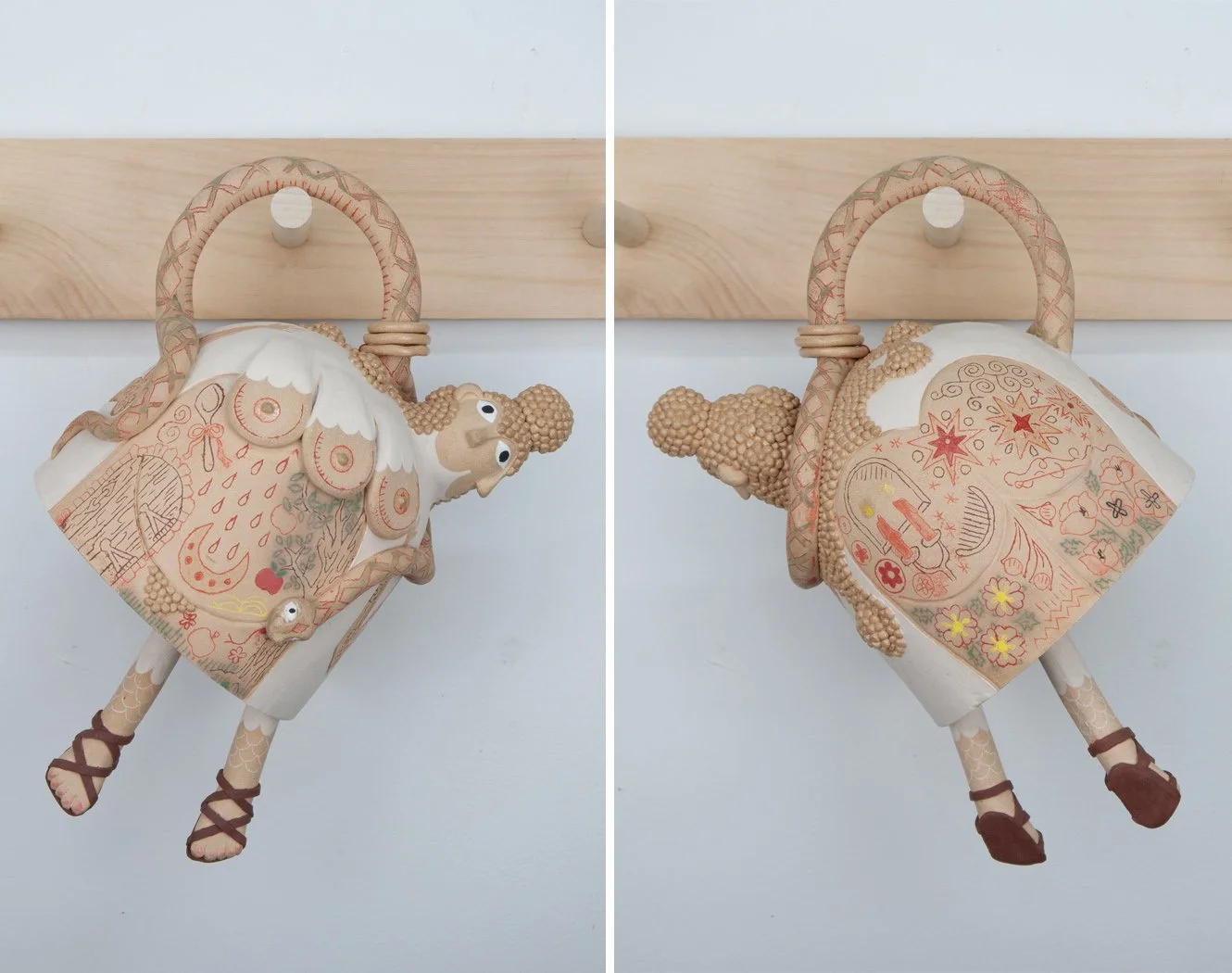
Idol (Lilith)
underglaze and glaze on stoneware, waxed thread; 8 x 7 x 10 in.
Link to a video of Lilith ringing:
Lilith—where to even f$!king begin.
Lilith did not come from nothing—out of nowhere. The thesis to so much of my research, to what I want to learn, is establishing historical connections to how society demonizes, dehumanizes and formulates the monstrous in order to recognize how it is done today. If you haven’t noticed in my work, the etymologies of words is where I normally like to start.
Lilith originated from the Sumerian lil- demons—lil- meaning ‘of the night.’ There are several lil- demons but the Lilu and Lilitu demons seem to be her origins. The earliest found cuneiform tablet mentioning these particular lil- demon was around 3000 BCE, in the Sumerian myth "Gilgamesh and the Huluppu Tree."
Lilu eventually fades away from the myths and incantations after a millennia or so leaving Lilitu to roam the nights, giving men wet dreams and other minor ailments.
The phonetic name "Lilith" begins to appear in writing as rabbis compiled and edited the Babylonian Talmud circa 500-600 CE. In the Talmud, Lilith is mentioned sparsely but it is clear that she is the Mother of Demons.
Controversial in religious circles, it is thought that Lilith, though not directly in name, is mentioned in the Book of Genesis, the first book of the Bible—writen sometime between the 15th and 5th century BCE. the Book of Genesis is written in two parts. Part two contains the widely popular Adam and Eve story where God first makes Adam and then fashions Eve from Adam’s rib so that Adam would not be lonely and have a helper. PART ONE, however, clearly states that a male and a female were created by God in His own image at the same time and from the same earth—though contested, some religious scholars believe that woman was Lililth, Adam’s EQUAL. I’ll stop there.
So so so so so sosososos much can be said about the misogynistic and monsterous telling and retelling of the story and history of Lilith. But for this post, I just focused on the origins of her name but I never knew about the lil-demons until recently.
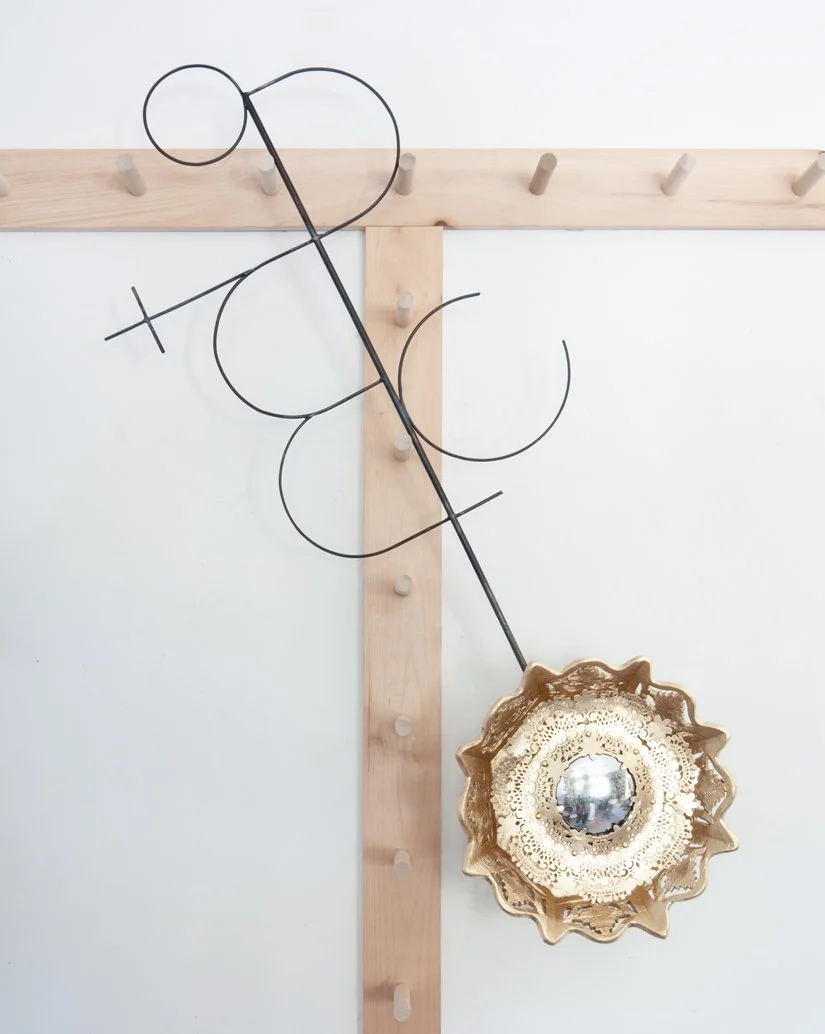
Cosmos
steel, wood, mirrored glass, gold leaf, brass; 43 x 19 x 3 in.
“[Capitalism] has stolen our cosmos and returned it in the form of Cosmopolitan magazine and cosmetics.” -Mary Daly; from Gyn/Ecology; 1978/reissued with new forward in 1990
“Even before witchcraft turned into a profitable concept, we may consider that the cosmetics industry, in particular, had succeeded in exploiting an obscure nostalgia for magic found among many women, by selling them its pots and vials, its miraculous ingredients, its promises of transformation and its immersion in a world of enchantment.” -Mona Chollet; In Defense of Witches; 2022
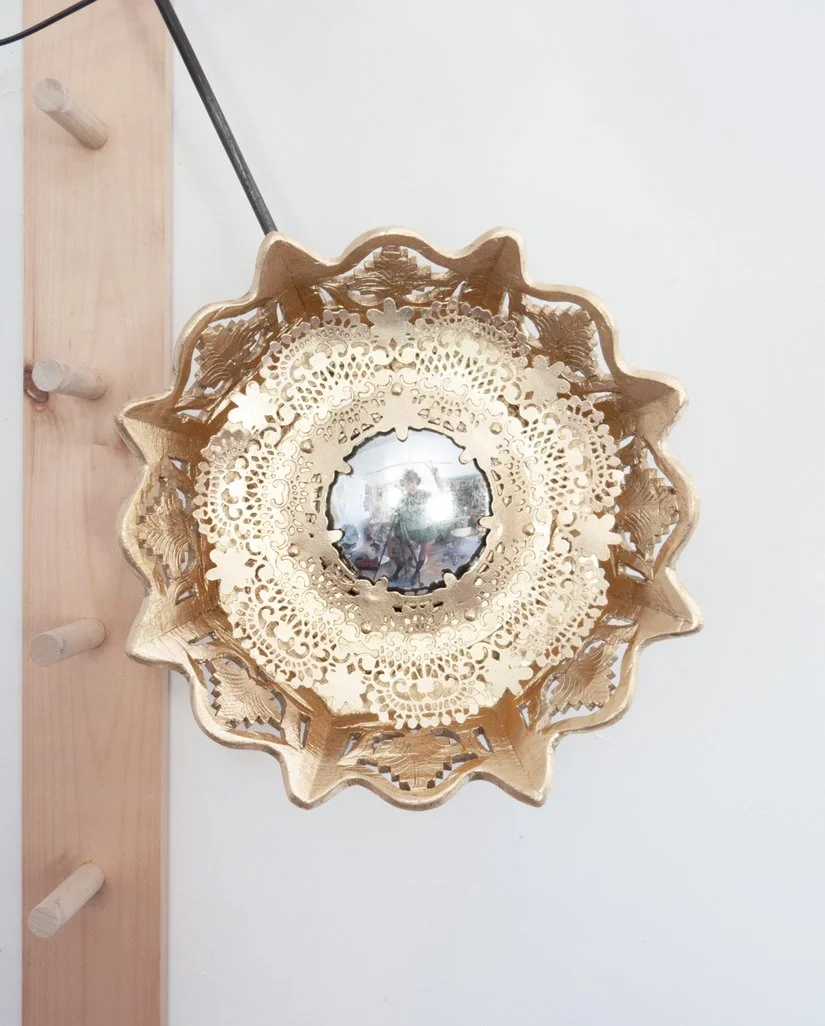
Cosmos
Detail

Spinster (We are Esther)
strips of clothing, steel, brass, pine; 75 x 96 x 24in.
Reclaiming Esther. With brevity, the Book of Esther is about a Jewish woman, Esther, who becomes Queen of Persia and ultimately, becomes the savior of the Jewish people from extermination.
Esther's story has been repurposed by the Heritage Foundation in Project Esther. It uses antisemitic conspiracy theories with the false claim of ‘defending’ Jews as a thin veil to attack the Palestinian liberation movement while aggressively ignoring right-leaning antisemitism.
Esther's womanhood has been reimagined by Christian Nationalists as an ideal woman who both engages in political action while remaining subservient to male authority around her. She has become a symbol for Moms of Liberty.
Esther, reclaimed by Jewish feminists, uses knowledge and power, albeit, through her marriage, to become a fighter for Jewish survival because of, and not in spite of, her skilled navigation of gendered and sexualized institutions.
On Spinster:
‘Spinster’ functions as a mediation on language—both as I am spinning the rope, spinning the rope onto the walls and letting my eyes spin in contemplating what I am writing. This project specifically focuses on how a historical phrase that still resonates today and how past stories can be manipulated for present uses.I
The needle lends itself to be a drawing tool leaving the thread as its mark. This work writes as drawing and draws as sculpture with the title of each wall drawing functioning as the key to its language.
On Spinster:
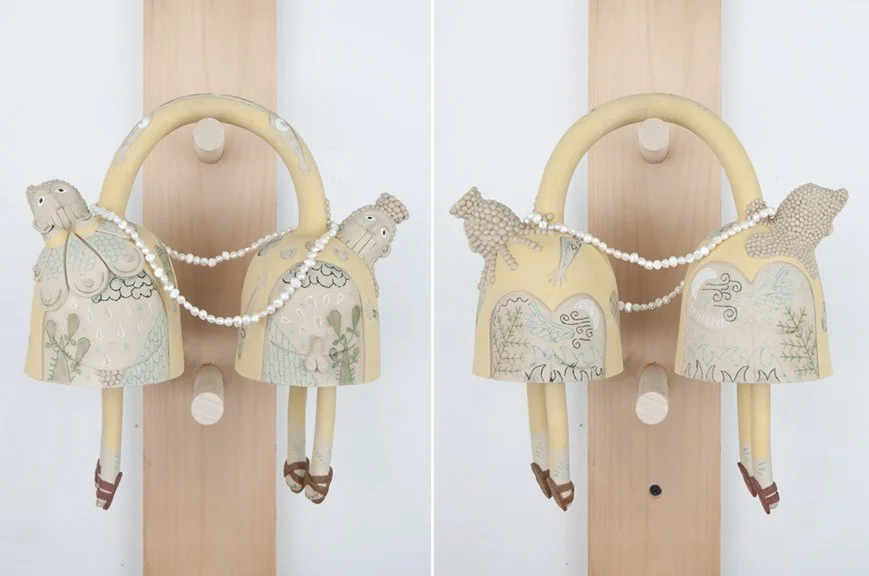
Idol (Lilitu and Lilu)
underglaze and glaze on stoneware, raw pearls, waxed thread; 10 x 3.5 x 10 in.
Four thousand or so years ago, between and around the Tigris and Euphrates rivers, in the rise of the ziggurats and the erection of a civilization, magical thinking guised as religion was well established.
Here, we have Lilitu (female night spirit/s that visited mostly men) and Lilu (male night spirit/s that visited mostly women). These nocturnal spirits posed little danger to the soul or person but were known to cause a wet dream from time to time and definitely were blamed for an unwanted or surprise pregnancy. Over time, the Lilu faded from the stories leaving the Lilitu to be morphed over the millenia to what a male dominated society needed her to be.
Link to a video of Lilth and Lilu ringing:

Gossip
steel, beeswax, wool, glass, Pink Moon water; 42 x 15 x 5 in.
Among the many things that have been written about gossip—its origins and cultural degradation—my recent favorite tidbit:
Shakespear’s had a way of permanently diverting the path of words through the popularity of his plays and poems. For example, in contemporaneous written accounts of James VI of Scotland’s baptism, roughly 1566, Queen Elizabeth I was recorded as being his gossip, a term meaning god-sibling or god-parent. Gossip, in this meaning of the term, originated hundreds of years if not a thousand years earlier.
By the height of Shakepear’s fame, beginning around 1592 and very possibly because of his plays, gossip became associated with idle chatter, mainly but not exclusively, among women.
This is yet another word that Shakepear’s writing has caused the downfall of.

Gossip
Detail

Idol (The Sybil)
underglaze on stoneware, wax thread, thread, laurel incense; 10 x 10 x 11 in.
The Sibyls—once great oracles and mystics who advanced and served the greats and the common many in ancient Greeks and Romans. By the early second millennium, the Sibyls transformed into snake-like seducers, tricking men into marrying or sleeping with them.
Interesting fact: until the Guttenberg press started standardizing spelling of words, the Hebrew ‘Lilith’ in Isaiah 34 was sometimes translated or conveniently changed into a Sibyl written in English.
___________
In 1391, Andrea de Barberino wrote an Italian chivalric romance call, in English, Guerrino the Wretch. It follows the adventures of this tricksterish and wiley orphan Guerrino as he attempts to find his father. At one point in his travels, he comes to a mountain pass in the Apennines when the devil suddenly appears and tells him that a great enchantress, the Sibilla, lives nearby.
The enchantress, the devil explains, rules over a vast subterranean kingdom, and earthly paradise that will be his to enjoy…He falls in love with this Sibilla who is the famous Cumaean Sibyl of ancient Rome. For a year, Guerrino is completely happy and this fairy kingdom, but he begins to notice that every Saturday his beloved, Sibyl and all her ladies walk themselves in their rooms over conned by curiosity, he pierced the door and see they have all transformed into a monster—a half human with serpentine legs. Horrified, Guerrino escapes and goes to Rome to be absolved of his year of sinful living.
Link to video for The Sybil:
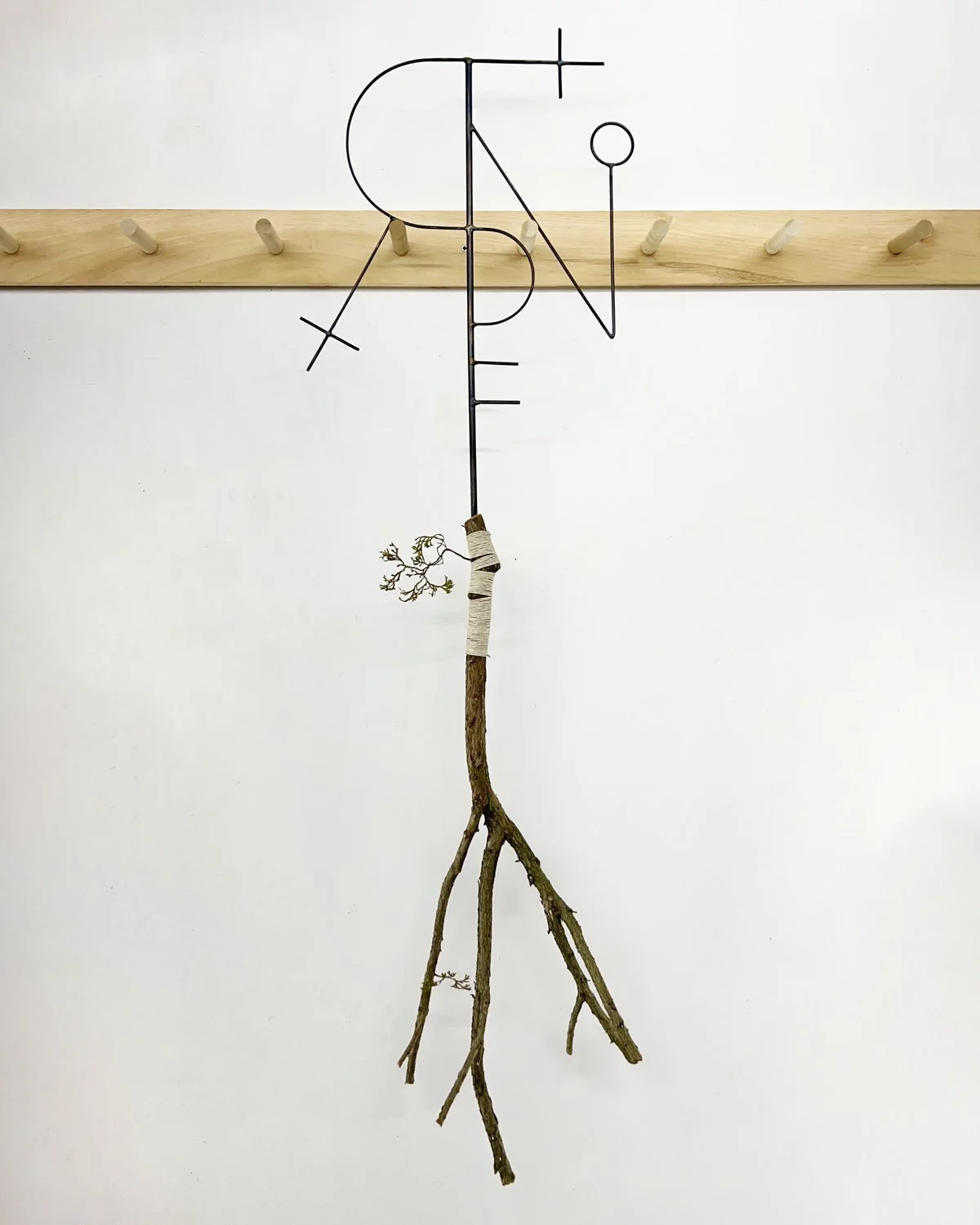
Sinister
steel, cypress, cotton; 15 x 7 x 50 in.
From Latin, sinistra, the root for sinister, means "left, on the left side." But since most humans were right handed, even 2,000 years ago, left hand folks was always kinda seen as suspect or weaker—unless you were a warrior, left handedness could offer you an element of surprise in one-on-one battle and in some ancient cultures, left-handed fighters were perceived as magical or having the gods on their side.
The “evilness” solidified upon the word sinister by the 14c. meaning "contrary, false; unfavorable; left-handed; to the left." This probably happened because of sinister’s association with divinations dating back to the ancient Romans. To the Roman seers, things moving to the left carried both good and bad omens, all depending on what was being “seen”—context and the “thing” was always important.
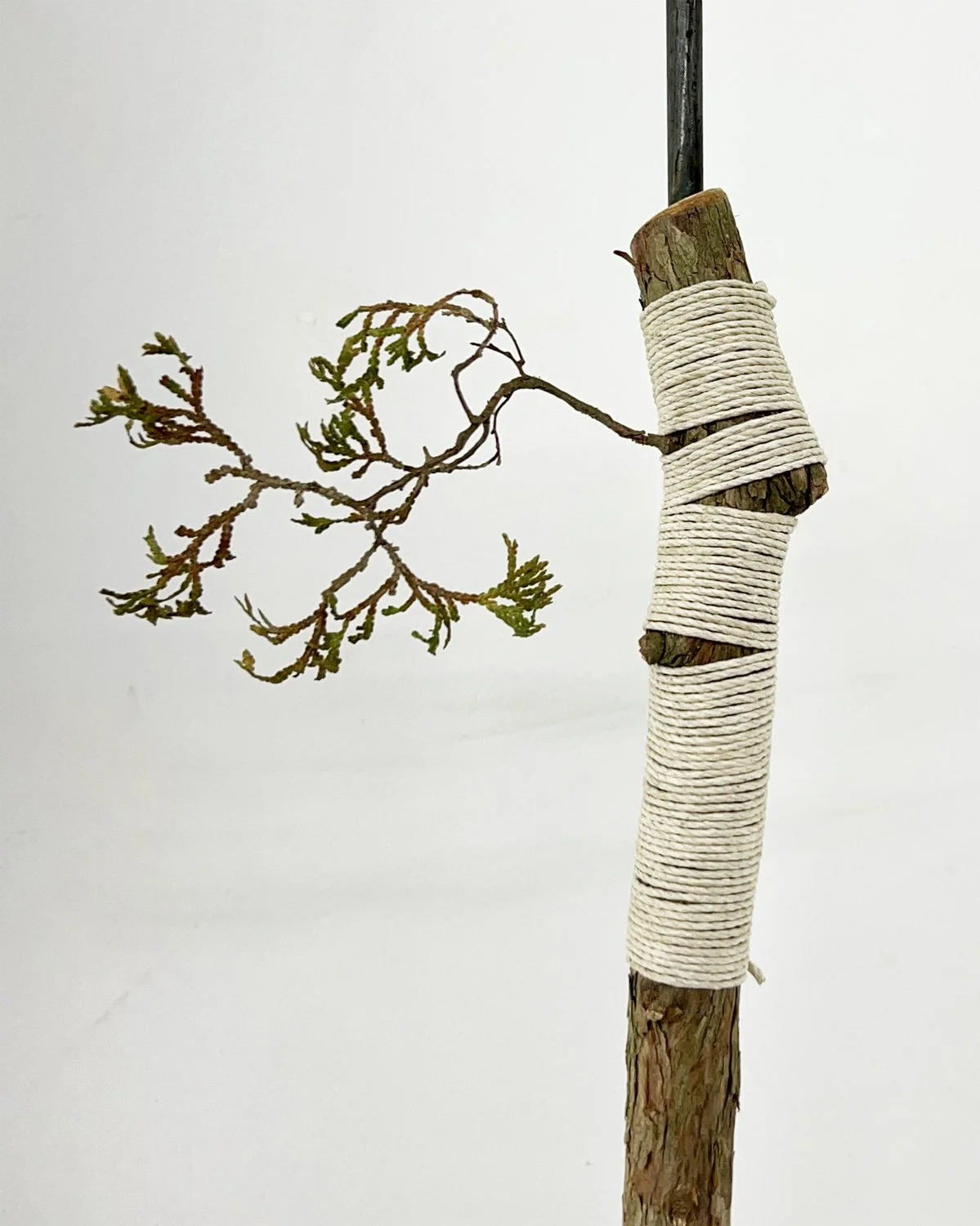
Sinister
Detail

Spinster (We know that we know)
strips of clothing, steel, brass, pine; 70 x 90 x 20 in.
This piece holds two ideas for me. First, every Spinster piece made is about me, a spinster—an unmarried childless person. But also about the medieval European occupation, a spinster—meaning ‘a woman who spins for a living.’ This was one of the few trades a single woman could have as an occupation to make their own money. And the Goddess Clotho, one of the three Fates in Greek mythology, who spins the thread of a person’s life, therefore, a spinster.
Historically, women have been the weavers and spinners of memory. They are the ones who keep alive the stories and knowledge of the past, tell the history of the community and are the ones who tell them to the future generations. Today, things known and learned can be deleted and rewritten to fit the powerful's goals. ‘We know that we know’ calls to share our knowledge even if it’s through an oral tradition.

Idol (Bason)
underglaze on stoneware, wax thread; 5 x 5 x 7 in.
Bason is known to be first and only mentioned in the Elizabethan grimoire, The Book of Oberon (1577), author/s unknown. I used the 2015 translation by Daniel Harms, James R. Clark, and Joseph H. Peterson. In this translation, Bason, the demon, is described as having the ability to make themselves invisible and can answer all of your questions. They have three heads, one of a dog, one like a man’s and another like a raven, has feet similar to a goshawk and spits fire from their mouth(1).
By the 16th century, the same century The Book of Oberon was written, the silk road and other major trade routes between the far east like China, Japan and Korea and Europe were well established and had been for centuries, if not a few millennia. Goods for trade, food, spices, stories, folklore, fears and hope all traveled these routes as well. It's very possible that a story of the mythical creature, the Basan, from far off in Japan could have made its way to Europe. The Basan, in Japanese folklore, is a fire breathing chicken that lives in the mountains of Iyo Province. It breathes a “ghost-fire” from its mouth and supposedly if a human hears the “basa basa'' sound it makes and tries to look for it, the Basan can suddenly vanish(2). Like a proverbial game of phone, stories change and get added on to and now this Japanese fire breathing mythical chicken has three heads—a dog, human, and raven—rides a wild bear and has long claws like a hawk but at least they remembered the invisibility, some of the fowl-like qualities and the fire breathing. This is just another way Christians and the West demonize the Other whether it is a person, place, thing, or animal.
Harms, Daniel, and James R. Clark. The Book of Oberon: A Sourcebook of Elizabethan Magic. Llewellyn Publications, 2015. Translation of the 1577 first edition.
From Wikipedia: https://en.wikipedia.org/wiki/Basan_(legendary_bird)#cite_note-Katsumi-1
Link to a video of Bason ringing:
On Bells:
Bells as toys:
My bells are formally and structurally based on the Boeotian bells from the Geometric period of Greece’s history. Archaeologists have found broken but only two complete simple terracotta female presenting bells with geometric patterns painted in black and fragments of possibly nine other bells. It is strongly suggested that these bells with their human genitalia are associated with cult rituals used to indicate the presence of a deity or deities. Some scholars believe these simple bells to be votives of toys associated with the Orphic myths regarding Dionysos. According to the Orphic myths, the Titans lured Dionysos to his death by enticing him from safety with the offer of toys. Spinning tops and bells are often included in the list of objects used by the Titans. Others scholars consider them to be just toys, labeling them “bell-shaped dolls” and not linking them to Dionysos or other deities. From my understanding and research, these terracotta bells were found all together in one location in Boeotia, Thebes and nowhere else in ancient Greece or Rome. Because of this, some scholars believe two things: first, they think one person made them for personal reasons and secondly, they are more crudely made and painted in comparison to the pottery of the time, meaning the creator had the access to the tools but was not an artisan. Moreover, bronze and iron bells have been known to be in circulation at the time but not in the form of a human figure like the Boeotian bells. It is also unclear to me if the bells were found alone with the other mentioned “toys” like the spinning tops but they are commonly lumped together in contemporary writings.
Bells as sacred-secular object:
My bells are thematically based on their sacred-secular significance in western histories. Bells are commonly associated with time, mystical happenings, and communications with deities, ancestors and the supernatural for thousands of years. In the Christian era, bells signified the arrival of the Holy Spirit and to announce the times of worship. Magical powers were attributed to the church bells especially because of their positions, hanging from the steeple between heaven and earth—the passage between worlds. And by the bell’s thunderous toll, it was believed that it scared away demons. In Hinduism, the ghanta are hand bells that are hung or placed at the temple entrance. Devotees would ring the bell while entering into the sanctum in order for the devotee to inform the deity of their arrival. The sound of the bell is considered auspicious which welcomes divinity and dispels evil. In Witchcraft and Wicca, the ringing of a bell tonally cleanse the ritual space as well as call in and out for the deity or ancestor.
Particularly, my bells draw from the redressing of Christian and Abrahamic demons. If today, we demonize the other and they demonize us. Who and what was demonized in the past to create the demons still referenced in some religions? My bells slip into syncretism—by us ringing them, they open a passage between worlds; by us ringing them, they know we are here; by us ringing them, we can tell their stories.

Spinster (Margaret Fernseed)
strips of clothing, steel, brass, pine; 85 x 70 x 20 in.
It was 1607, Peckham, England. There was a married woman on trial, Margaret Fernseed—She was loud; she was aggressive; she was scold; she was rude; She confessed to owning a brothel; She confessed to being a brothel madam; She confessed to a beating women; She confessed to entrapping young women into prostitution; She was quite an awful person but she insisted she did not murder her husband.
So why, in the count records, did the courts begin their murder case referring to Mrs. Fernseed, as she was Mr. Fernseed’s wife, then abruptly begin to recognize her as a spinster, which in 1607 definition, is an unmarried childless woman?
According to Blessin Adams 2025 book, Thou Savage Woman, “The reason behind [this] was, is that married women were legally subsumed under their husbands. So they were not legally autonomous individuals. And so this raised a tricky legal problem. If women were not legal individuals, and that they were entirely under the responsibility of the husband, and they must obey their husband in EVERYTHING, when they[the wife] commits a crime, who is responsible?”
The wife could argue, and according to Adams, they have before this case under the above logic, that “yes, I did commit a crime but my husband told me so. And I must obey my husband in all things.” Note: Mrs. Fernseed did not claim this. She defended her innocence.
However, the courts work around, in this case and for the future, is to forcibly annul the marriage–declaring a marriage void, as if it never existed. Hence, making the woman, Mrs. Fernseed, a spinster (BTW, they never referred to her in her maiden name, always her married name) and allowing the court to fully adjudicate the crime and punishment of murdering a town man, who was, now, never her husband.
Mrs. Fernseed was convicted of Mr. Fernseed’s murder on circumstantial evidence, in no small part due to her poor reputation and hung.
Scholar
yarn, steel, slate, kranite, felt and other diverse things; 60 x 68 x 6 in.
I planned out this rug last fall, I was thinking about historical scholars and knowledge seekers in western histories that were accused of heresy; I was thinking about how many demons I have come across in western esoterica that were called upon to gain knowledge in the sciences—biology, astrology, alchemy and anatomy; I was thinking about mythological spirits of knowledge, Hecate and Morgana, who were maliciously maligned, pushed aside for the rise of Christianity.
I started knotting this rug as government websites were scrubbed and changed to remove references to inclusion, diversity, gender and as well as minorities and transgendered people, among other terms, in January; I knotted this rug as I watched the news of Columbia Univ. Grad student Mahmoud Khalil got ripped away from his pregnant US Citizen wife in March; I knotted this rug in April following the news about the current US administration attacking universities; I knotted this rug in May as I watched President Trump sign an executive order seeking to stop direct federal funding to NPR and PBS.
On Rugs:
If you think of my work as a family tree, my rugs are the parents to the carpet beaters, the bells, the needle and possibly future work. The rugs represent a more of an archetypal or totemic figure—the Whore, the Crone, the Warrior, the Mother and the Heretic, to name a few.
I see rugs as objects of spatial transitions and a protective barrier—their soft borders protecting whether they are on the wall, floor or resting on one's shoulders. Keeping in mind notions of the occult, the rugs take on the motif of the magic circle which, in itself, is a boundary but it is also more than that—it is a passage, a gateway, a portal between the natural and supernatural. The rug is not necessarily used to hide something from us but to reveal the hiddenness in the world, our world—the world-in-itself vs. the world-for-us.
Scholar
Detail
Scholar
Detail
Scholar
Detail
Idol (Lilith)
underglaze and glaze on stoneware, waxed thread; 8 x 7 x 10 in.
Link to a video of Lilith ringing:
Lilith—where to even f$!king begin.
Lilith did not come from nothing—out of nowhere. The thesis to so much of my research, to what I want to learn, is establishing historical connections to how society demonizes, dehumanizes and formulates the monstrous in order to recognize how it is done today. If you haven’t noticed in my work, the etymologies of words is where I normally like to start.
Lilith originated from the Sumerian lil- demons—lil- meaning ‘of the night.’ There are several lil- demons but the Lilu and Lilitu demons seem to be her origins. The earliest found cuneiform tablet mentioning these particular lil- demon was around 3000 BCE, in the Sumerian myth "Gilgamesh and the Huluppu Tree."
Lilu eventually fades away from the myths and incantations after a millennia or so leaving Lilitu to roam the nights, giving men wet dreams and other minor ailments.
The phonetic name "Lilith" begins to appear in writing as rabbis compiled and edited the Babylonian Talmud circa 500-600 CE. In the Talmud, Lilith is mentioned sparsely but it is clear that she is the Mother of Demons.
Controversial in religious circles, it is thought that Lilith, though not directly in name, is mentioned in the Book of Genesis, the first book of the Bible—writen sometime between the 15th and 5th century BCE. the Book of Genesis is written in two parts. Part two contains the widely popular Adam and Eve story where God first makes Adam and then fashions Eve from Adam’s rib so that Adam would not be lonely and have a helper. PART ONE, however, clearly states that a male and a female were created by God in His own image at the same time and from the same earth—though contested, some religious scholars believe that woman was Lililth, Adam’s EQUAL. I’ll stop there.
So so so so so sosososos much can be said about the misogynistic and monsterous telling and retelling of the story and history of Lilith. But for this post, I just focused on the origins of her name but I never knew about the lil-demons until recently.
Cosmos
steel, wood, mirrored glass, gold leaf, brass; 43 x 19 x 3 in.
“[Capitalism] has stolen our cosmos and returned it in the form of Cosmopolitan magazine and cosmetics.” -Mary Daly; from Gyn/Ecology; 1978/reissued with new forward in 1990
“Even before witchcraft turned into a profitable concept, we may consider that the cosmetics industry, in particular, had succeeded in exploiting an obscure nostalgia for magic found among many women, by selling them its pots and vials, its miraculous ingredients, its promises of transformation and its immersion in a world of enchantment.” -Mona Chollet; In Defense of Witches; 2022
Cosmos
Detail
Spinster (We are Esther)
strips of clothing, steel, brass, pine; 75 x 96 x 24in.
Reclaiming Esther. With brevity, the Book of Esther is about a Jewish woman, Esther, who becomes Queen of Persia and ultimately, becomes the savior of the Jewish people from extermination.
Esther's story has been repurposed by the Heritage Foundation in Project Esther. It uses antisemitic conspiracy theories with the false claim of ‘defending’ Jews as a thin veil to attack the Palestinian liberation movement while aggressively ignoring right-leaning antisemitism.
Esther's womanhood has been reimagined by Christian Nationalists as an ideal woman who both engages in political action while remaining subservient to male authority around her. She has become a symbol for Moms of Liberty.
Esther, reclaimed by Jewish feminists, uses knowledge and power, albeit, through her marriage, to become a fighter for Jewish survival because of, and not in spite of, her skilled navigation of gendered and sexualized institutions.
On Spinster:
‘Spinster’ functions as a mediation on language—both as I am spinning the rope, spinning the rope onto the walls and letting my eyes spin in contemplating what I am writing. This project specifically focuses on how a historical phrase that still resonates today and how past stories can be manipulated for present uses.I
The needle lends itself to be a drawing tool leaving the thread as its mark. This work writes as drawing and draws as sculpture with the title of each wall drawing functioning as the key to its language.
On Spinster:
Idol (Lilitu and Lilu)
underglaze and glaze on stoneware, raw pearls, waxed thread; 10 x 3.5 x 10 in.
Four thousand or so years ago, between and around the Tigris and Euphrates rivers, in the rise of the ziggurats and the erection of a civilization, magical thinking guised as religion was well established.
Here, we have Lilitu (female night spirit/s that visited mostly men) and Lilu (male night spirit/s that visited mostly women). These nocturnal spirits posed little danger to the soul or person but were known to cause a wet dream from time to time and definitely were blamed for an unwanted or surprise pregnancy. Over time, the Lilu faded from the stories leaving the Lilitu to be morphed over the millenia to what a male dominated society needed her to be.
Link to a video of Lilth and Lilu ringing:
Gossip
steel, beeswax, wool, glass, Pink Moon water; 42 x 15 x 5 in.
Among the many things that have been written about gossip—its origins and cultural degradation—my recent favorite tidbit:
Shakespear’s had a way of permanently diverting the path of words through the popularity of his plays and poems. For example, in contemporaneous written accounts of James VI of Scotland’s baptism, roughly 1566, Queen Elizabeth I was recorded as being his gossip, a term meaning god-sibling or god-parent. Gossip, in this meaning of the term, originated hundreds of years if not a thousand years earlier.
By the height of Shakepear’s fame, beginning around 1592 and very possibly because of his plays, gossip became associated with idle chatter, mainly but not exclusively, among women.
This is yet another word that Shakepear’s writing has caused the downfall of.
Gossip
Detail
Idol (The Sybil)
underglaze on stoneware, wax thread, thread, laurel incense; 10 x 10 x 11 in.
The Sibyls—once great oracles and mystics who advanced and served the greats and the common many in ancient Greeks and Romans. By the early second millennium, the Sibyls transformed into snake-like seducers, tricking men into marrying or sleeping with them.
Interesting fact: until the Guttenberg press started standardizing spelling of words, the Hebrew ‘Lilith’ in Isaiah 34 was sometimes translated or conveniently changed into a Sibyl written in English.
___________
In 1391, Andrea de Barberino wrote an Italian chivalric romance call, in English, Guerrino the Wretch. It follows the adventures of this tricksterish and wiley orphan Guerrino as he attempts to find his father. At one point in his travels, he comes to a mountain pass in the Apennines when the devil suddenly appears and tells him that a great enchantress, the Sibilla, lives nearby.
The enchantress, the devil explains, rules over a vast subterranean kingdom, and earthly paradise that will be his to enjoy…He falls in love with this Sibilla who is the famous Cumaean Sibyl of ancient Rome. For a year, Guerrino is completely happy and this fairy kingdom, but he begins to notice that every Saturday his beloved, Sibyl and all her ladies walk themselves in their rooms over conned by curiosity, he pierced the door and see they have all transformed into a monster—a half human with serpentine legs. Horrified, Guerrino escapes and goes to Rome to be absolved of his year of sinful living.
Link to video for The Sybil:
Sinister
steel, cypress, cotton; 15 x 7 x 50 in.
From Latin, sinistra, the root for sinister, means "left, on the left side." But since most humans were right handed, even 2,000 years ago, left hand folks was always kinda seen as suspect or weaker—unless you were a warrior, left handedness could offer you an element of surprise in one-on-one battle and in some ancient cultures, left-handed fighters were perceived as magical or having the gods on their side.
The “evilness” solidified upon the word sinister by the 14c. meaning "contrary, false; unfavorable; left-handed; to the left." This probably happened because of sinister’s association with divinations dating back to the ancient Romans. To the Roman seers, things moving to the left carried both good and bad omens, all depending on what was being “seen”—context and the “thing” was always important.
Sinister
Detail
Spinster (We know that we know)
strips of clothing, steel, brass, pine; 70 x 90 x 20 in.
This piece holds two ideas for me. First, every Spinster piece made is about me, a spinster—an unmarried childless person. But also about the medieval European occupation, a spinster—meaning ‘a woman who spins for a living.’ This was one of the few trades a single woman could have as an occupation to make their own money. And the Goddess Clotho, one of the three Fates in Greek mythology, who spins the thread of a person’s life, therefore, a spinster.
Historically, women have been the weavers and spinners of memory. They are the ones who keep alive the stories and knowledge of the past, tell the history of the community and are the ones who tell them to the future generations. Today, things known and learned can be deleted and rewritten to fit the powerful's goals. ‘We know that we know’ calls to share our knowledge even if it’s through an oral tradition.
Idol (Bason)
underglaze on stoneware, wax thread; 5 x 5 x 7 in.
Bason is known to be first and only mentioned in the Elizabethan grimoire, The Book of Oberon (1577), author/s unknown. I used the 2015 translation by Daniel Harms, James R. Clark, and Joseph H. Peterson. In this translation, Bason, the demon, is described as having the ability to make themselves invisible and can answer all of your questions. They have three heads, one of a dog, one like a man’s and another like a raven, has feet similar to a goshawk and spits fire from their mouth(1).
By the 16th century, the same century The Book of Oberon was written, the silk road and other major trade routes between the far east like China, Japan and Korea and Europe were well established and had been for centuries, if not a few millennia. Goods for trade, food, spices, stories, folklore, fears and hope all traveled these routes as well. It's very possible that a story of the mythical creature, the Basan, from far off in Japan could have made its way to Europe. The Basan, in Japanese folklore, is a fire breathing chicken that lives in the mountains of Iyo Province. It breathes a “ghost-fire” from its mouth and supposedly if a human hears the “basa basa'' sound it makes and tries to look for it, the Basan can suddenly vanish(2). Like a proverbial game of phone, stories change and get added on to and now this Japanese fire breathing mythical chicken has three heads—a dog, human, and raven—rides a wild bear and has long claws like a hawk but at least they remembered the invisibility, some of the fowl-like qualities and the fire breathing. This is just another way Christians and the West demonize the Other whether it is a person, place, thing, or animal.
Harms, Daniel, and James R. Clark. The Book of Oberon: A Sourcebook of Elizabethan Magic. Llewellyn Publications, 2015. Translation of the 1577 first edition.
From Wikipedia: https://en.wikipedia.org/wiki/Basan_(legendary_bird)#cite_note-Katsumi-1
Link to a video of Bason ringing:
On Bells:
Bells as toys:
My bells are formally and structurally based on the Boeotian bells from the Geometric period of Greece’s history. Archaeologists have found broken but only two complete simple terracotta female presenting bells with geometric patterns painted in black and fragments of possibly nine other bells. It is strongly suggested that these bells with their human genitalia are associated with cult rituals used to indicate the presence of a deity or deities. Some scholars believe these simple bells to be votives of toys associated with the Orphic myths regarding Dionysos. According to the Orphic myths, the Titans lured Dionysos to his death by enticing him from safety with the offer of toys. Spinning tops and bells are often included in the list of objects used by the Titans. Others scholars consider them to be just toys, labeling them “bell-shaped dolls” and not linking them to Dionysos or other deities. From my understanding and research, these terracotta bells were found all together in one location in Boeotia, Thebes and nowhere else in ancient Greece or Rome. Because of this, some scholars believe two things: first, they think one person made them for personal reasons and secondly, they are more crudely made and painted in comparison to the pottery of the time, meaning the creator had the access to the tools but was not an artisan. Moreover, bronze and iron bells have been known to be in circulation at the time but not in the form of a human figure like the Boeotian bells. It is also unclear to me if the bells were found alone with the other mentioned “toys” like the spinning tops but they are commonly lumped together in contemporary writings.
Bells as sacred-secular object:
My bells are thematically based on their sacred-secular significance in western histories. Bells are commonly associated with time, mystical happenings, and communications with deities, ancestors and the supernatural for thousands of years. In the Christian era, bells signified the arrival of the Holy Spirit and to announce the times of worship. Magical powers were attributed to the church bells especially because of their positions, hanging from the steeple between heaven and earth—the passage between worlds. And by the bell’s thunderous toll, it was believed that it scared away demons. In Hinduism, the ghanta are hand bells that are hung or placed at the temple entrance. Devotees would ring the bell while entering into the sanctum in order for the devotee to inform the deity of their arrival. The sound of the bell is considered auspicious which welcomes divinity and dispels evil. In Witchcraft and Wicca, the ringing of a bell tonally cleanse the ritual space as well as call in and out for the deity or ancestor.
Particularly, my bells draw from the redressing of Christian and Abrahamic demons. If today, we demonize the other and they demonize us. Who and what was demonized in the past to create the demons still referenced in some religions? My bells slip into syncretism—by us ringing them, they open a passage between worlds; by us ringing them, they know we are here; by us ringing them, we can tell their stories.
Spinster (Margaret Fernseed)
strips of clothing, steel, brass, pine; 85 x 70 x 20 in.
It was 1607, Peckham, England. There was a married woman on trial, Margaret Fernseed—She was loud; she was aggressive; she was scold; she was rude; She confessed to owning a brothel; She confessed to being a brothel madam; She confessed to a beating women; She confessed to entrapping young women into prostitution; She was quite an awful person but she insisted she did not murder her husband.
So why, in the count records, did the courts begin their murder case referring to Mrs. Fernseed, as she was Mr. Fernseed’s wife, then abruptly begin to recognize her as a spinster, which in 1607 definition, is an unmarried childless woman?
According to Blessin Adams 2025 book, Thou Savage Woman, “The reason behind [this] was, is that married women were legally subsumed under their husbands. So they were not legally autonomous individuals. And so this raised a tricky legal problem. If women were not legal individuals, and that they were entirely under the responsibility of the husband, and they must obey their husband in EVERYTHING, when they[the wife] commits a crime, who is responsible?”
The wife could argue, and according to Adams, they have before this case under the above logic, that “yes, I did commit a crime but my husband told me so. And I must obey my husband in all things.” Note: Mrs. Fernseed did not claim this. She defended her innocence.
However, the courts work around, in this case and for the future, is to forcibly annul the marriage–declaring a marriage void, as if it never existed. Hence, making the woman, Mrs. Fernseed, a spinster (BTW, they never referred to her in her maiden name, always her married name) and allowing the court to fully adjudicate the crime and punishment of murdering a town man, who was, now, never her husband.
Mrs. Fernseed was convicted of Mr. Fernseed’s murder on circumstantial evidence, in no small part due to her poor reputation and hung.

















